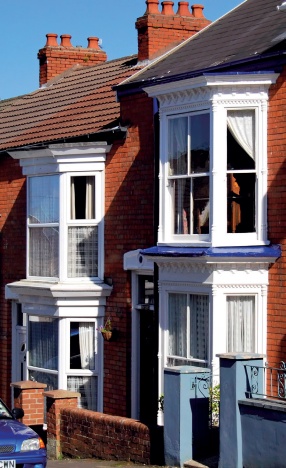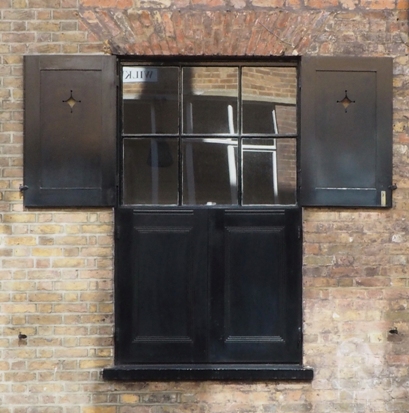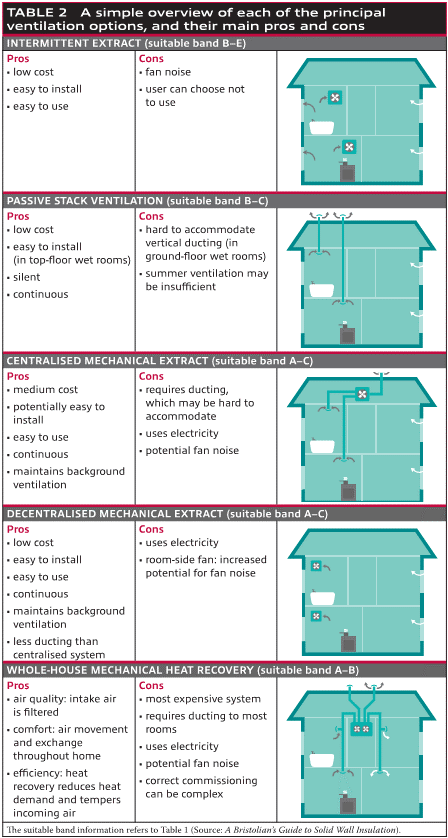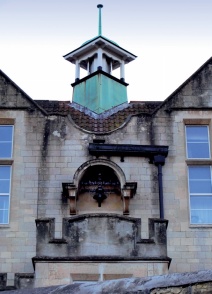Indoor Air Quality and Ventilation
in Traditional Buildings
Nicholas Heath
 |
|
| Solid brick walls, bay windows and tiled roofs in a typical Edwardian terrace. Venting top and bottom, the original vertical sliding sashes (right) offer controlled and highly efficient air circulation when retrofitted with draught seals. |
When people think of retrofit, the first thing that springs to mind is often insulation. This is perhaps unsurprising, given the increasing and logical preference for a fabric-first approach to improving energy efficiency. However, for a retrofit to be thorough and low risk in the long term, insulation is just one part of the equation. To maintain the health of both buildings and occupants, insulation must be part of a wider, whole-building approach that also considers indoor air quality and ventilation, among other things.
Much has been written about the energy efficiency of traditional buildings and construction materials. Rather than focussing purely on thermal performance, this article is concerned with the movement of air and moisture both in and around building fabric. This issue can be split into two broad areas: first, the moisture characteristics of the fabric elements themselves; and second, the junctions and spaces between the various building fabric elements.
BUILDING FABRIC AND MOISTURE
Many traditional building materials allow some degree of moisture movement within the fabric. Different terms are used to describe this, with ‘permeability’ or ‘breathability’ being among the most common, but these do not present the full picture. ‘Moisture open’ is a more holistic term, covering the following key areas:
- vapour permeability – a material’s ability to allow water vapour to pass through it
- capillarity – a material’s ability to draw up or transfer liquid water
- hygroscopicity – a material’s ability to absorb, temporarily ‘store’ and then release water molecules from the surrounding environment as relative humidity changes (often called moisture buffering).
When adding insulation to traditional building fabric, it is essential that these characteristics are considered and compatible systems are used in order to minimise the risk of excessive moisture building up in or on materials.
Insulation and airtightness systems then need to be applied coherently to avoid similar moisture build-up issues as a result of either a) cold bridges at uninsulated areas or b) moisture building up within or on fabric.
The unintended consequences of excess moisture build-up as a result of imperfect retrofit are becoming more and more widely recognised, and these include not only cosmetic and fabric damage but also decreased air quality and its potential negative health impacts. In extreme cases, the moisture balance between ingress (rainfall on the outer face of a wall, for example) and evaporation may be tipped, so a structure becomes progressively more cold and damp, which in turn attracts more condensation until saturation occurs.
VENTILATION AND AIRTIGHTNESS
Ventilation is defined in the current Building Regulations as ‘the removal of “stale” indoor air from a building and its replacement with fresh outside air’. It is needed not only to control internal moisture levels but also to get rid of pollutants and to maintain an indoor environment that is healthy for both the occupants and the fabric. In uninsulated older buildings ventilation is often largely uncontrolled and relies on a combination of gaps in the building fabric, window and door opening and more deliberate measures like chimneys and other vents. In many cases this ventilation can be excessive, particularly at colder and windier times of year, resulting in substantial and unnecessary heat loss. However, it is essential to maintain controlled, intended ventilation paths.
TABLE 1 Air permeability ratings for existing homes |
|||
Band |
Air permeability (m³/hr/m²@50Pa) |
Described condition |
|
A |
Less than 3 |
Very airtight |
|
B |
Between 3 and 5 |
Fairly airtight |
|
C |
Between 5 and 10 |
Acceptably airtight |
|
D |
Between 10 and 20 |
Not airtight - a leaky building |
|
E |
Above 20 |
Between 3 and 5 very leaky |
|
| (Source: A Bristolian’s Guide to Solid Wall Insulation) | |||
When a building is insulated, it is likely to ‘behave’ differently as a result. In particular, its internal conditions are likely to change. Relative humidity may be more prone to increases, for example, particularly where occupants are unaware of the change in building conditions and do not adjust their ventilation or other habits accordingly. The more comprehensive the retrofit, the more likely it is that such changes will occur.
A common contributor to such changes is an increase in airtightness, often as an unintentional by-product of adding insulation which blocks up previous air leakage routes. Without adequate ventilation, moisture in the building is now less able to escape, and this can cause problems even where moisture-open insulation systems are used (although such systems should considerably ease the moisture transfer process).
This is exacerbated where insulation is partial (leaving some cold surfaces) and where intended as well as unintended ventilation routes are blocked up, leading to problems such as moisture build-up in cold voids (roof spaces and cellars for example) or deterioration of air quality in the occupied spaces.
More holistic retrofit projects often deliberately target improved airtightness, with the aim of sealing up unintended ventilation routes and thereby reducing unwanted heat loss. This is a sensible strategy, but must include consequential measures such as additional controlled ventilation to ensure that indoor air quality remains good.
Deliberately making a building more airtight and then having to add more ventilation may seem like a paradox, but the key issue here is one of controllability. Uncontrolled ventilation can cause excessive heat loss, uncomfortable draughts and locally poor air quality; controlled ventilation keeps indoor air quality good while minimising heat loss and increasing comfort levels.
A COHERENT APPROACH
The aim, then, is to:
- reduce heat loss via insulation and airtightness
- retain a moisture balance in the building fabric via a coherent, thorough application of appropriate systems and through additional intentional ventilation where necessary
- retain good indoor air quality via an adequate, fool-proof ventilation strategy.
A successful retrofit considers insulation, airtightness and ventilation as integrated parts of a whole-building approach.
ASSESSING VENTILATION NEEDS
If considering a retrofit project on an older building, particularly a deep retrofit that aims to insulate all parts of the building and increase its airtightness, it is essential to consider the ventilation requirements at the outset. Perhaps the best piece of advice is to seek the services of a reputable, independent ventilation expert with experience of retrofitting traditional buildings and an understanding of the issues covered in this publication.
As part of the assessment process, it is helpful to establish current airtightness levels and ventilation provision in the building, as well as any residual moisture or likely future moisture load. Informal initial checks should include intended ventilation routes (such as gaps below doors, wall and window vents, chimneys, extractor fans, roof and sub-floor vents) and unintended ventilation routes (such as structural cracks, poorly-fitting windows and doors, gaps between floorboards and at floor perimeters), and can be simply and effectively informed by occupant experience. For a more formal measurement, airtightness may be measured by a fan pressurisation test, a fairly simple measurement of the building’s air permeability (AP, measured in m3/hr/m2@50Pa).
 |
|
| Shutters on the ground floor of a Georgian terrace in Spitalfields, London: commonly used on the continent to keep interiors shaded and ventilated during the day, here the focus was on privacy and security. |
It is then necessary to identify the airtightness level being targeted by the retrofit project. This is also commonly measured in terms of AP. For context, current Building Regulations require new-build homes to achieve an AP of 5, while the default assumption for an older home is likely to be much worse.
The table above provides an example of different ratings and what they mean. (This table is taken from the recent retrofit publication A Bristolian’s Guide to Wall Insulation, which provides detailed guidance on many of the principles outlined in this article.)
Identifying the baseline performance will help identify air leakage routes that should be targeted for improvement and intended ventilation paths that must be maintained, while identifying the target AP will help inform the amount and type of ventilation provision likely to be needed.
Once a retrofit project starts, repeat fan pressurisation tests can be very helpful, both during the retrofit (to check that planned airtightness works have been effective) and afterwards (to identify the actual airtightness of the retrofitted building).
As well as understanding baseline and post-retrofit airtightness and ventilation performance, there are a number of other issues which require consideration at the planning stage to ensure that a healthy indoor environment is maintained:
- Moisture buffering – the use of a fully moisture-open insulation system will support the performance of the ventilation system, providing a greater ‘buffer’ for moisture management when needed.
- Airtightness method – as well as coherent design, the manner in which airtightness is to be achieved merits consideration. The more complex the system (a moisture-closed insulation system, for example, or one that relies on extensive use of tapes and/or membranes) the greater the potential for application errors or future failure, in contrast to a simpler system (a wet lime plaster finish and/or backing coat for a wood-fibre insulation system, for example) which could be more robust in the longer term.
- End-use and end-users – how is the building going to be used post-retrofit and who will be using it? How engaged are they? What, if any, behavioural changes may be needed? Are they tech-savvy or would a simple, passive ventilation system suit them better? All these questions need to be answered to inform the design of a suitable ventilation strategy.
Considering all these aspects before embarking on building work is more likely to result in a successful retrofit.
VENTILATION OPTIONS
Once a thorough assessment of insulation, airtightness and ventilation has been made, an appropriate ventilation system needs to be identified. There are many different types of ventilation system, all with different pros and cons (see Table 2). Broadly these divide into passive and mechanical systems. Passive ventilation systems work on the basis that warm air rises and avoids the need for extractor fans. Ducts rise through the building to the roof, extracting moist air from bathrooms and kitchens. The extracted air is replaced by air drawn in from outside through adjacent rooms, so the whole house is naturally ventilated. These systems rely on changing air pressures and particularly on wind movement over roof vents, so the design of the system must be carefully considered and they are not always suitable or feasible.
 |
The simplest mechanical ventilation systems use the same system of air displacement but use fans to extract moist air from those rooms with the highest moisture level. These may be intermittent (a simple extractor fan in a bathroom for example, activated by a humidistat) or constantly operating at a low speed (a ‘decentralised mechanical extract ventilation system’ or DMEV). More complex systems have centralised fans and can be either continuous or demand controlled. In theory this makes the systems more reliable and the fans can be less noisy as they are located in loft spaces or cupboards.
Mechanical ventilation and heat-recovery (MVHR) systems are the most complex mechanical systems, having a heat exchanger and two sets of ducts, one to extract moist air and the other to supply fresh air back to the adjacent rooms, preheated using the heat from the waste air. MVHR systems are generally best suited to comprehensive retrofits where a high level of airtightness is achieved.
The type of system suitable for a building depends largely on its post-retrofit airtightness and on the configuration of the building in question – not all older buildings can accommodate the ducting or fan units required for some ventilation systems. Other factors such as complexity and occupant type must also be considered, as they can be key determinants of success.
UNHEATED AREAS
It is important that ventilation requirements are also assessed and addressed for unheated areas of a building such as roof and sub-floor spaces. Where insulation or airtightness are improved in a home, this can make unheated areas colder and less well ventilated, particularly if measures are applied incorrectly (sub-floor vents being blocked by insulation, for example, or loft hatches being left uninsulated).
For unused roof spaces, adding significant levels of ceiling-level insulation will make the roof space colder, increasing the likelihood of condensation and associated problems, and increasing the risk of water tanks and pipework freezing unless these are also adequately insulated. Moisture-related problems are exacerbated where gaps in the insulation and airtightness layer (such as loft hatches or spotlight openings) allow warm, moisture-laden air to enter the roof space, and where insulation blocks existing vents. While such problems may be minimised by good practice and attention to detail, additional ventilation may be needed in any case, typically in the form of eaves, ridge or slate vents, for example.
It should also be borne in mind that in the UK’s temperate climate, external ventilation often admits warm moisture-laden air. As warm air can carry more moisture than cool air, condensation may occur in a void cooled by high levels of insulation. So, increasing ventilation levels can bring its own issues, and uncontrolled ventilation may simply add to the problem. Ventilation paths must be carefully thought through to ensure that the overall strategy is effective and appropriate, and avoids stagnant pockets of air.
Ventilation in sub-floor spaces can already be compromised by the build-up of debris in the floor void and/or in and around vents, which again presents risks of condensation and associated issues. Any such blockages should be removed as part of a retrofit project, and care must be taken to avoid blocking up ventilation routes with insulation, and to increase ventilation provision if necessary.
Where the building is in an area with high levels of radon, strategies for ventilation (both sub-floor and for the main building), airtightness and insulation will require particular consideration.
SAFEGUARDING PERFORMANCE
‘Despite all efforts made in its provision, ventilation is still one of the most difficult aspects to safeguard in use’ (Designing Out Unintended Consequences, see Further Information).
 |
|
| A 1930s copper cupola providing passive stack ventilation on a former school building in Bath |
Once a ventilation system has been chosen, the key question is: how can its operation and performance be maintained in the long term? Or, more simply, how much risk can be designed out? This is a vital question, and covers the following considerations:
- Design – is the designer experienced in traditional building retrofit and do they understand the systems under consideration?
- Installation and commissioning (particularly for higher-end ventilation systems) – is a specialist installer being used, or at the very least is the installer familiar with the selected system? Leading on from this, will the system be commissioned by an expert?
- Control and use – are the end-users engaged? How simple can the system and its controls be made? How foolproof is the system? How will users know if it fails? Are the maintenance needs clear? What are the consequences of failure?
- Supplementing ventilation provision (leading on from the previous question) – is supplementary ventilation available (use of windows, for example) in case of system failure?
To maximise chances of success, insulation must be considered alongside airtightness and ventilation, following a whole-building approach to retrofit. Worst-case scenarios must be anticipated and risk designed out accordingly – this will often lead to simpler, more foolproof solutions rather than overly-complicated designs. The building must be considered in the context of its users and their behaviours. Experienced designers, installers and commissioners must be used, and occupants must be involved from the outset and be made fully aware of any behavioural impacts and maintenance needs in the future.
At the heart of all this lies understanding: ‘Regardless of your reasons for retrofitting, the key to success is understanding. Understand your home, your lifestyle, your environment, your priorities, the upgrade measures available, the importance of careful planning and detailing, and the whole-house approach and joined-up process’. (A Bristolian’s Guide to Solid Wall Insulation)
~~~
Further Information
Bristol City Council/STBA, A Bristolian’s Guide to Solid Wall Insulation, BCC, 2015
C King and C Weeks, Designing Out Unintended Consequences When Applying Solid Wall Insulation, BRE, 2016
N May and N Griffiths, Planning Responsible Retrofit of Traditional Buildings, STBA, 2015
Royal College of Physicians, Every Breath We Take: The lifelong impact of air pollution, 2016
T Sharpe et al, Characteristics and Performance of MVHR Systems, Innovate UK, 2016
R Sharpe et al, ‘Higher Energy Efficiency Homes are Associated with Increased Risk of Doctor-diagnosed Asthma in a UK Sub-population’, Environment International, Vol 75, 2015
Zero Carbon Hub, Ventilation in New Homes, 2016



